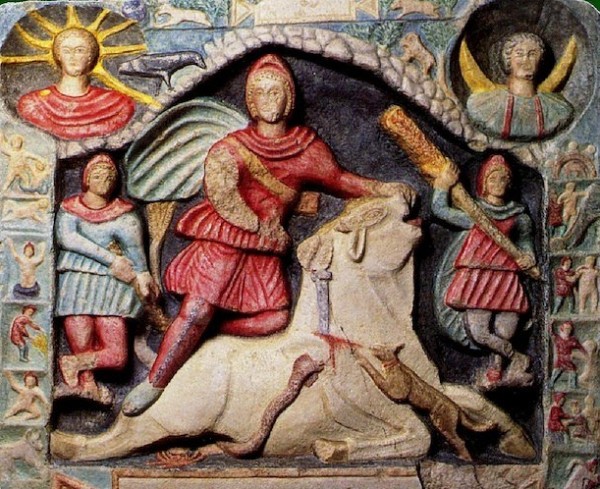
Whence We Came? Volume 3: Mithraism
Photo Credit: www.strangenotions.com
“Whence we came?” is an aged old question. We know the Grand Lodge of England was formed in 1717, but where did the four lodges that formed the Grand Lodge come from? How far back do our traditions go? Does our ancestry really date only so far back as the age of taverns and bars? Over the next series of articles, we will explore our history and in the process, travel through time to ancient lands and rediscover ancient wisdoms. This month we explore Ancient Persia and the Mysteries of Mithraism.
Whence We Came? Mithraism
We began our journey in Ancient Egypt with Osiris, we moved to the Dionysian Artificers of Greece, and now we find ourselves in Persia and the mysteries of Mithras.
Mithras mysteries were first instituted by Zoroaster, the great Eastern Magi. Under this myth, the Supreme Being created Light, and from this light came the God, Ormuzd. In turn, Ormuzd, with the great omnificent word, created the world. He produced superior and lessor genies, who were the guardian angels of the world, whose chief was Mithras. The Supreme being also created Ahriman, or as the western world would refer to him, Satan. Between Ormuzd and Ahriman, we have the principles of light and dark, good and evil. While Ahriman would corrupt man, there was always the belief in the ultimate triumph of Ormuzd and victory of light and good over dark and evil.
Mithras was worshiped as a sun God, and in Persia the Mithras festival was celebrated during the winter solstice (December 21). Could this be the derivation of masons celebrating St John the Evangelist, whose feast day is on December 27? Is our circumambulation around the alter following the path of the sun from the East to the South to the West and back to the East a celebration of Mithras, the sun God? Is our Worshipful Master, represented by the sun, actually a representation of Mithras? Interestingly, Mithras is always identified by wearing a Phrygian cap, and our Worshipful Master “may be known by wearing a hat, a cap, or some suitable covering”. A Phrygian cap was a symbol of freedom and liberty, and sometimes referred to as a liberty cap. Is this our man, free-born requirement?
The initiate to the mysteries of Mithras was tested through seven degrees of trials and tribulations, trials so arduous, that at times it even led to the death of the candidate. Is this where we get the term, “you have a rough and rugged road to travel, where you will meet with ruffians, and may lose your life”?
The candidate was tested by water and fire (think about our oaths, “my body buried between hi and lo water mark”, “my bowels taken thence, and burnt to ashes”). The candidate was led into a dark cavern, enveloped in darkness, where he was tormented by all kinds of wild beasts (“and given to the beasts of the field and the vultures of the air as a prey”). Towards the end of the degrees he was buried for many days up to his neck in snow (once again, “buried between hi and lo water mark”)?
The candidate was offered a crown to which he was to refuse and state that “Mithras alone is his crown”. The true mason strives to circumscribe his desires and passions, so that his spiritual soul can overcome his earthly physical body.
In the finality of the degree, the candidate was led from darkness to light, where he found himself in the presence of Archimagus, the chief priest, and the assistant dispensers of light. It was here that the candidate received the sacred word, which included the ineffable name of God, and was instructed in the secret doctrines of Mithraism. Is this not our degree system, where the candidate is brought from darkness to light, and into the presence of the Worshipful Master surrounded by the brethren, and is then presented with masonic light, the grip, and the word? Do we not learn the ineffable name of God in the Holy Royal Arch?
We also find in some temples a statute of a man dressed in lion skin with a lion headdress (is that our lion’s paw?), entwined by a snake, standing on top of a globe (symbol of the spiritual over the material) and at the bottom certain working tools that include a hammer and Vulcan pliers. Albert Mackey stipulates that Vulcan was the pagan God, Tubal-Cain.
In Rome, where Mithras became popular, the initiated were known as “those united by a
handshake”.
Mithras is typically seen being born out of a rock. Is this our imperfect rough ashler, from whence we all come?
If one looks at Mithras straddling the bull in the famous tauroctony scene, he is knelling on the bull with his left knee, his right forming an angle of a square behind the bull’s hoof, clearly in the position of an Entered Apprentice. In the scene, one will see images of the sun, moon, stars. Two men holding torches, one up and one down (as above, so below). The blood oozing from the bull is typically in the form of ears of wheat. (Is this our sheaf of wheat in the Fellow Craft degree?)
Are we the care takers of the Mithras mysteries? Are our lodges representations of the caverns used as Mithras Temples? Maybe it’s all just a coincidence. Next month, we will leave the ancient East and travel to Rome where we will find ourselves among the skillful men of the Roman Collegia.
RW Michael S Neuberger
Grand Historian – 2017[/vc_column_text][/vc_column][/vc_row][vc_row][vc_column][vc_btn title=”Download PDF” color=”blue” align=”center” button_block=”true” link=”url:http%3A%2F%2Fnjgl.wpengine.com%2Fwp-content%2Fuploads%2F2018%2F04%2F03-July-Issue-%25E2%2580%2593-Mithras.pdf||target:%20_blank|”][/vc_column][/vc_row]
